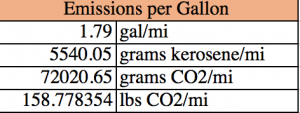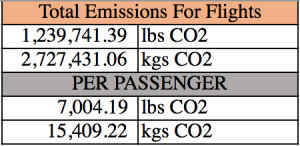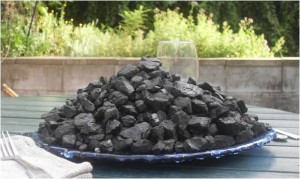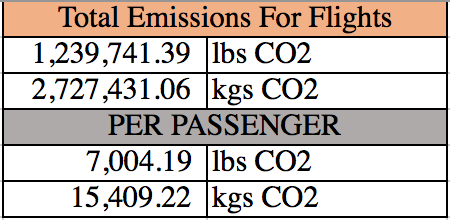Some time ago I posted about the carbon emissions that would be resulting from the mosaic’s travels to Peru. I was recently contacted by a professor at Dickinson, who informed me that my calculations were drastically off. I promptly investigated the claim and found that he was right. So, after several checks and some reworking of my excel document I present the new information. It is a stunning shift (and not in a good way).




So, here is the sad part of the mosaic. Our trip involves six flights. Two flights to get to Lima, two to get back to the states, and two flights while in Peru (to Cusco and back). During this, we will be emitting about 7000 pounds of one of our favorite greenhouse gasses. That is equivalent to burning 3410 pounds of coal (EPA). If any of my past readers will recall I posted a photo of 8 pounds of coal on a plate. It would take just over 426 of those plates to account for that much coal, or the biggest dinner party you have ever been to. In my mind, things have changed as I have corrected the numbers. Instead of 3 of those plates of coal, it is 426. This is a big investment. We need to make it worth it.


Justin- This definitely makes one think about how to make burning fossil fuels “worth-it”. I feel we can make it worth it, especially after a semester of preparation behind us. Is there a way to make air travel more carbon neutral? In a globalized world, it’s hard for me to imagine societies retreating from its dependency on air travel for keeping connected, doing business, and medical needs to name a few purposes of air travel in the modern world.
Justin – glad to see you revisit this and correct your previous calculations. Air travel is one of the most carbon intensive activities and adds a great deal to the carbon footprints of those of us who do it.
What can/should we do about the carbon we will put into the atmosphere by traveling to and in Peru for the Mosaic?
Didn’t the group to Durban purchase offsets? This seems like a cop (haha) out, but may be worth us considering if this is something we are serious about.
I know you mean this light-heartedly Will. But I don’t see this as a cop-out. Members of the COP17 Dickinson delegation purchased offsets from the Durban Community-Ecosystem Based Adaptation Initiative (Durban CEBA; http://www.cop17-cmp7durban.com/en/offset-your-footprint/the-durban-ceba-initiative.html), which employed low income and unemployed South Africans in restoring natural ecosystems in downtown and outlying areas of Durban, ‘cleaning and greening’ neighborhoods, and working on community development projects to build climate resilience. So besides offsetting ghg emissions, funds from our purchase of offsets were used to try to do some real good in Durban, the host city for the conference. Also, most, if not all, of the student delegates to COP17 have drawn on their experience in the Mosaic to continue to be active on climate change.
Having decided to burn large amounts of carbon to attend a COP, there comes a responsibility to give back for this privilege. Offsets, thoughtfully purchased from an organization that is doing good work, can be one meaningful component of how we meet our obligation.
That’s great Neil, I didn’t realize those where the credits that were purchased. How did you all go about finding that project? Could we find something similar in Lima?
I dug around the COP20 website for a bit, but turned up nothing. Any thoughts Neil?
Thanks for correcting this Justin. This seems like a topic that would be worth us talking about as mosaic students sometime, maybe over 426 pounds of cafeteria dinner?
To me this means that we really need to go with a clear purpose. I think that us being signatures to the Trillion Tonne Comunique would be a bid deal and give us something to talk about in Lima. Maybe that is our contribution to help “offset” our carbon expenditure?
We are doing research, but I wonder how we can turn that around and educate our peers when we come back, it seems like we have an obligation to share this experience with others. We have to spend carbon to save carbon? Seems so, but lets make every molecule of CO2 we put up there worth it.
I think that if we could somehow figure out this offset piece of it all, the TTC would be an incredible addition to that. But you are definitely right, that bringing back what we have learned will help us with our quandary of how to ensure that the carbon we spend is worth it. Maybe the documentary is a good avenue for this; we could take it in an educational direction.